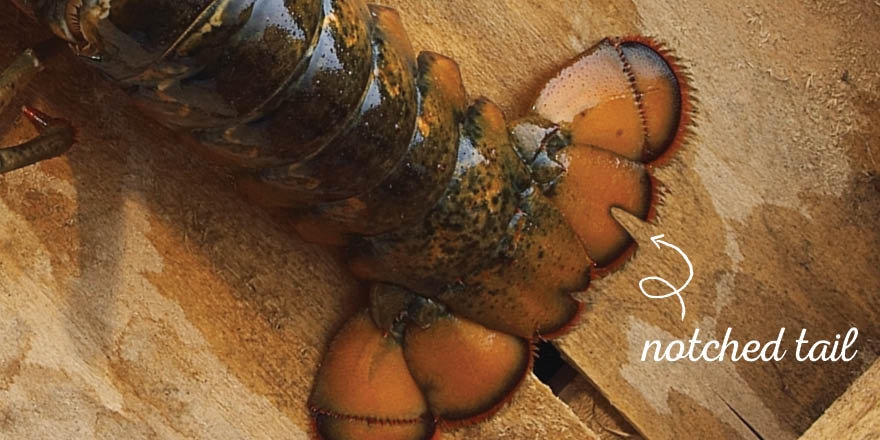Lobster notching is a long-standing practice used to support the sustainability of lobster populations This process involves cutting a distinctive V-shaped notch in a lobster’s tail to mark and protect reproductive female lobsters But why go through the extra effort of notching lobsters? As it turns out, this simple act provides significant benefits for the lobster fishing industry and marine ecosystem.
What is Lobster Notching?
Lobster notching programs first emerged in the 1940s and remain a key management strategy today. The practice involves using a knife or other tool to cut a shallow V-shaped notch in the tail flipper of an egg-bearing female lobster. This notch is meant to be permanent enough to last through several molts.
The notch serves as an identifying marker, signaling to fishermen that the lobster should be returned to the water rather than harvested. By sparing these mature females, notching allows them to continue reproducing and contributing to the future lobster population.
Why Bother with Notching Lobsters?
Notching lobsters supports conservation in several important ways
Preserving Breeding Stock
The notch identifies the most reproductively valuable lobsters in the population – mature, egg-bearing females. Letting these lobsters go preserves breeding stock and allows more offspring to be produced. Just one female lobster can produce thousands of eggs per year, so ensuring their survival is key.
Long-Term Benefits
Lobsters molt to grow, shedding their hard exoskeleton. The notch remains visible even after molting, protecting females through multiple breeding cycles over several years. Just one V-notched lobster may survive to reproduce for up to five more years.
Supporting Genetic Diversity
By protecting a variety of mature females, notching helps maintain genetic diversity in the overall population. This diversity enhances resilience against disease and environmental changes.
Complementing Size Regulations
Minimum and maximum size limits are also used to manage lobster fisheries. Notching adds another layer of protection for prime reproductive lobsters that meet legal harvest sizes.
Easy Identification
The V-notch is an easy visual cue. Fishermen can quickly identify and return notched lobsters to the water when emptying traps, improving efficiency.
Notching Guidelines and Regulations
While guidelines vary regionally, some general notching best practices include:
-
Targeting mature females carrying eggs with a carapace length of at least 3.5 inches
-
Cutting V-notches 1/4 inch deep in the middle flipper of the tail
-
Discarding any previous notch if found, replacing it with a new V-notch
-
Avoiding repeat notching after initial notch has been made
-
Releasing notched lobsters as soon as possible after notching
-
Abiding by regulations; it is illegal to possess or sell notched lobsters
Notching is mandatory for licensed lobster fishermen in many states. Violations of notch regulations can lead to significant penalties and the loss of fishing licenses.
The Impact of Notching on Lobster Populations
Research shows lobster notching programs effectively increase egg production and juvenile recruitment:
-
In Maine, V-notched lobsters were found to be 2-5 times more reproductively productive than unnotched legal-sized lobsters.
-
One study in Massachusetts estimated a single notched female lobster contributed around 80,000 more eggs per year than lobsters without notches.
-
Models suggest just 5-10% of the female lobster population needs to be notched to substantially boost juvenile numbers.
Where mandated, notching has helped some lobster fisheries rebound from near collapse. By supporting recruitment, it preserves the livelihoods of commercial lobstermen and the availability of lobster for seafood lovers!
Why Notch Lobsters?
- Protecting reproductive stock
- Maximizing egg production
- Maintaining genetic diversity
- Complementing other regulations
- Improving efficiency via visual identification
- Increasing juvenile lobster numbers
- Aiding population resilience
- Preventing overfishing
- Promoting a sustainable fishery
This straightforward method has demonstrated benefits for lobster conservation and the fishing industry. While not a standalone solution, notching remains an important strategy for responsible lobster management. The continued participation of fishermen, regulators, and consumers is key in safeguarding these iconic crustaceans for generations to come.

Wegmans Lobster V-Notch Story
FAQ
Why do fishermen notch lobsters?
Do lobsters feel the notch?
Where to notch a female lobster?
Why do some female lobsters not breed?
Why are lobster tails notched?
Notching may also act as an extra layer of protection on top of legislation. In early 2023, two fishing companies in Cornwall were prosecuted for catching berried lobsters and together fined more than £50,000. In one case, the lobsters’ tails had been scrubbed to remove evidence of eggs.
How does Bailey notch a lobster?
Bailey cuts a small “V” into its dappled royal-blue and yellow tail before gently laying the lobster back in the water. Now she is marked as illegal for others to land – and with any luck her reproductive potential is secured for a few more years. V-notching is a conservation method used to help replenish lobster stocks.
Does V-notching affect lobster value?
Although it is difficult to measure the impact of V-notching, Ireland’s Seafood Development Agency (BIM) has tried: it gives 70% of a lobster’s value if they are taken to a fisheries officer to be notched.
Does a notch in a lobster’s tail cause pain?
“If anything happens to the lobster population where the level drops too low, then it takes a long time to recover,” says Chris Weston, a technician at the National Lobster Hatchery in Padstow, some 40 miles away on Cornwall’s north coast. Making a notch in the lobster’s tail. The process is not thought to cause the crustacean pain.
